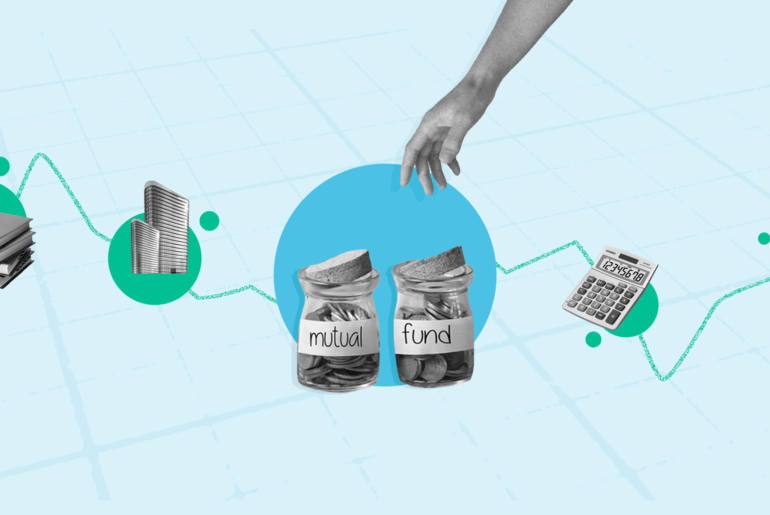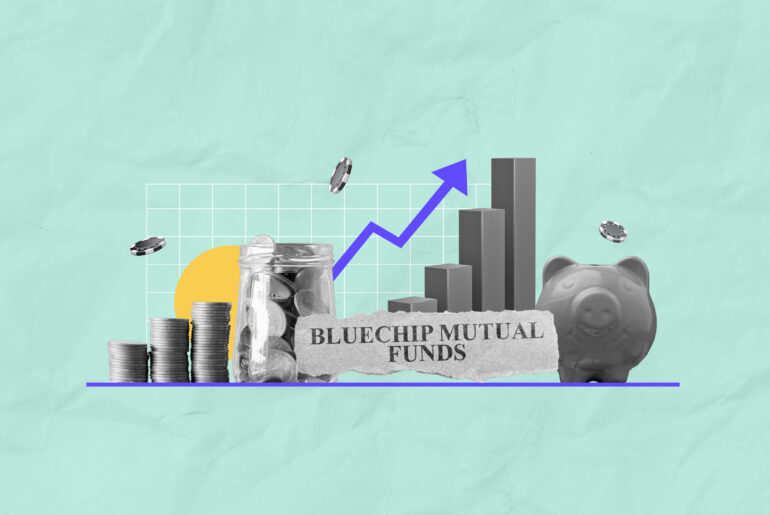Last Updated on May 13, 2025 by vanessa sequeira
Not every investor would like to invest time in constantly monitoring their investment portfolio. Passive mutual funds are one of the popular investments offering facilities for both active and passive fund management. Here in this article, we learn about passive investments, the top passive mutual funds, and the pros and cons of passive mutual funds for investors.
Table of Contents
Best Mutual Funds for Passive Investors
| Name | Sub Category | AUM | CAGR 3Y | Expense Ratio | Sharpe Ratio | CAGR 5Y | % Largecap Holding |
| Parag Parikh Flexi Cap Fund | Flexi Cap Fund | 98,541.28 | 23.95 | 0.62 | 0.82 | 29.09 | 60.24 |
| HDFC Flexi Cap Fund | Flexi Cap Fund | 74,105.46 | 27.99 | 0.81 | 0.93 | 33.10 | 72.64 |
| ICICI Pru Bluechip Fund | Large Cap Fund | 68,033.75 | 22.44 | 0.85 | 0.47 | 26.62 | 81.50 |
| ICICI Pru Value Discovery Fund | Value Fund | 51,111.88 | 24.84 | 1 | 0.72 | 31.46 | 64.21 |
| SBI BlueChip Fund | Large Cap Fund | 51,010.20 | 19.06 | 0.82 | 0.50 | 24.11 | 82.41 |
| Kotak Flexicap Fund | Flexi Cap Fund | 50,811.65 | 21.27 | 0.65 | 0.39 | 24.40 | 70.05 |
| SBI Contra Fund | Contra Fund | 44,068.57 | 26.45 | 0.63 | 0.23 | 37.31 | 49.78 |
| Nippon India Large Cap Fund | Large Cap Fund | 39,677.38 | 24.94 | 0.68 | 0.35 | 29.61 | 82.61 |
| Mirae Asset Large Cap Fund | Large Cap Fund | 38,891.55 | 17.40 | 0.55 | 0.53 | 23.03 | 83.53 |
| Nippon India Multi Cap Fund | Multi Cap Fund | 38,636.66 | 28.14 | 0.75 | 0.26 | 35.12 | 46.54 |
Note: The information is dated 13th May 2025. The parameters used to filter the list of mutual funds for passive investors on Tickertape are:
- Category – Equity
- Plan – Growth
- AUM – From Rs. 5,000 (sorted from highest to lowest)
- Sharpe ratio is set from 0
- 5yr CAGR
- Large-cap holdings 40% and above
Overview of the Best Mutual Funds for Passive Investors
Passive mutual funds in India are gaining popularity among those who prefer a hands-off approach to investment. Below is a list of the best passive funds 2025:
This fund aims to deliver long-term capital growth by actively managing a diversified portfolio of equity and equity-related securities. With a flexible investment approach across market capitalisations and sectors, it seeks to adapt to varying market conditions.
The fund focuses on generating capital appreciation and income by predominantly investing in equity and equity-related instruments. Among the top passive mutual funds, it offers the flexibility to invest across large-cap, mid-cap, and small-cap stocks, enabling dynamic asset allocation.
ICICI Prudential Bluechip Fund
Designed to generate long-term capital appreciation and income, this fund primarily invests in equity and equity-related securities of large-cap companies. It targets stable and established businesses with strong fundamentals.
ICICI Prudential Value Discovery Fund
With an emphasis on value investing, this fund seeks to deliver returns through capital appreciation and dividend income. It invests in a well-diversified portfolio of undervalued stocks that have the potential for long-term growth.
This fund also follows a value-driven approach, aiming to provide returns through a mix of dividend income and capital appreciation. It focuses on building a diversified portfolio of fundamentally strong large-cap companies.
Who Are Passive Investors?
As the name suggests, the passive investor is the one who doesn’t want to play an active role in keeping track of the investments. They look for passive funds for long-term that can deliver decent returns. This approach is known as ‘buy and hold’ in the investment world. That means the investor buys the investment and holds it for a long time, irrespective of the market fluctuations. The investor doesn’t react to short-term movements in the market. In simple terms, passive investors follow an invest-and-forget approach.
What are Passive Mutual Funds?
Passive mutual funds are investment funds that aim to replicate the performance of a specific market index or benchmark, such as the Nifty 50 or Sensex, rather than trying to outperform it. These funds do not require active management, as they simply invest in the same securities that make up the index.
The primary goal of passive funds is to match the returns of the market index they track, rather than actively selecting stocks or making frequent trades based on market predictions. The approach typically leads to lower management fees compared to actively managed funds. This makes passive funds an attractive option for long-term investors seeking consistent returns without the need for constant monitoring.
Taxation on Mutual Funds for Passive Investors
The Union Budget 2024 has introduced significant changes to the taxation of equity mutual funds, simplifying the tax structure while altering rates and benefits. Here is a detailed breakdown of the new tax rules:
- Tax-Free Limit: Gains up to Rs. 1.25 lakh in a financial year remain tax-free. This limit has been increased from the previous threshold of Rs. 1 lakh.
- Tax Rate: Any gains above Rs. 1.25 lakh are taxed at a flat rate of 12.5%. It was previously taxed at 10%.
- Indexation: It’s important to note that the benefit of indexation, which previously allowed investors to adjust the purchase price of their assets for inflation, has been removed for all asset classes, including equity mutual funds.
| Capital Gains Tax | Holding Period | Old Rate | New Rate |
| Short-Term Capital Gains (STCG) | Less than 12 months | 15% | 20% |
| Long-Term Capital Gains (LTCG) | More than 12 months | 10% | 12.50% |
No Indexation Benefit: This change affects the overall tax liability, potentially increasing it for long-term investors.
How to Choose the Best Mutual Funds for Passive Investors?
When investing in passive funds, keep the following factors in mind to find the best passive funds with high returns that suit your financial goals:
- Focus on Index Funds and ETFs: These funds track market indices, providing broad market exposure with minimal involvement. Examples include passive index funds in India like the Nifty 50 Index Fund.
- Low Expense Ratios: While exploring passive mutual funds for wealth creation, look for funds with lower management fees to maximise net returns.
- Tracking Accuracy: Select funds that closely replicate the performance of their underlying indices for consistent returns. This is a crucial factor when comparing passive funds vs active funds.
- Long-Term Performance: Check the fund’s historical performance to ensure it aligns with your financial goals.
- Diversification: Look for low-cost passive funds in India that invest across various sectors and asset classes to reduce risk.
- Fund Manager’s Reputation: Although passive investment funds require less active management, a reliable AMC ensures operational efficiency, making them part of the top passive mutual funds list.
Advantages of ‘Buy and Hold’ Investing
Unlike active investments, passive funds are ideal for the ‘buy and hold’ strategy, which has several advantages:
- Minimal Monitoring: With passive equity funds for SIP, you don’t have to keep track of the market actively. The buy and hold approach ensures your investment remains steady.
- One-Time Investment: This strategy is supported by strong analysis, making it a fairly reliable option for passive mutual funds India.
- Tax Efficiency: The investor is taxed based on long-term capital gains, a benefit often associated with the best passive mutual funds.
- Lower Costs: Frequent trading involves several additional costs. However, in the buy and hold strategy, as the investment is for the long term, you save on transaction costs.
Risks Associated with ‘Buy and Hold’ Investing
Though there are many advantages to the passive investment strategy of buy and hold, there are a few cons, such as:
- Your money is locked: If you have any financial emergency or find any better active and passive mutual funds, you can’t take advantage of the funds.
- Missed opportunities: At times, investors make good profits in active investing. However, those following what is passive investing might miss out on those opportunities.
- Investment risks: Though the passive investment meaning of buy and hold investing seems simple and safe, it is important to note that all investments carry a certain amount of risk. There is no guarantee that even a carefully chosen passive fund will perform well in the long term.
Factors to Consider Before Investing in Mutual Funds for Passive Investors
When exploring passive mutual fund options, here are key factors to consider:
- Investment Goals: For example, if your goal is retirement planning, a broad-based index fund like the Nifty 50 Index Fund could be ideal.
- Risk Tolerance: If you prefer low-risk options, consider debt index funds like a Government Bond ETF. These funds suit investors who understand what is a passive fund and prioritise stability.
- Fund Expenses: Consider a fund with a low expense ratio over one with a higher fee for higher net profits.
- Market Conditions: During a market downturn, you might lean toward funds tracking defensive sectors, such as healthcare ETFs. This approach integrates the principles of active and passive mutual funds, balancing risk and reward.
- Tax Implications: Passive equity funds held for over one year qualify for long-term capital gains tax benefits.
To Wrap It Up
Overall, the buy-and-hold investment strategy is one of the popular approaches for passive investors. An investor need not worry about the market. Now that you know what is passive investing, investors should do their own research to become a long-term investment with a good amount of money and time.
FAQs
1. What is the minimum investment period for long-term investment?
The investments with a horizon of 5 yrs or more are considered long-term investments. However, it varies according to investment goals.
2. What is the tax levied on long-term capital gains on mutual funds?
The tax levied on long-term capital gains on mutual funds depends on the types of mutual funds.
– Equity funds (more than 12 months) are taxed at 12.5% on the amount more than Rs. 1 lakh without indexation.
– Debt funds (more than 36 months) are taxed at 20% with indexation benefit.
– Unlisted equity funds (more than 36 months) are taxed at 20% with indexation benefit.
3. What types of mutual funds are best for passive investors?
Passive investors can research index funds and exchange-traded funds (ETFs) that track major indices like the Nifty 50 or Sensex. These funds offer low fees, broad market exposure, and typically match the performance of the market, making them ideal for long-term investors with minimal involvement.
4. How do I ensure my passive mutual fund investment remains low-risk?
To minimise risk, research about funds with broad diversification, such as large-cap or multi-cap index funds. Funds that track established indices, like the Nifty 50, provide stable returns and are less volatile. Additionally, consider funds with low expense ratios and a consistent performance history.
5. What are passive mutual funds, and how do they differ from active funds?
Passive mutual funds track a specific market index, such as the Nifty 50 or Sensex, aiming to replicate its performance. They do not require active management, unlike active funds where fund managers make investment decisions to outperform the market. As a result, passive funds have lower expense ratios and are ideal for hands-off investors.
- How To Withdraw Mutual Funds? - Jun 6, 2025
- Top Maternity Insurance With Low Waiting Periods - Jun 5, 2025
- ROE vs ROCE – What are the Differences? - Jun 5, 2025





